Sculpture at the Ends of Slavery by Caitlin Meehye Beach
Reviewed by Kim OrcuttKim Orcutt
Independent scholar
Email the author: kimorcutt301[at]gmail.com
Citation: Kim Orcutt, book review of Sculpture at the Ends of Slavery by Caitlin Meehye Beach, Nineteenth-Century Art Worldwide 23, no. 1 (Spring 2024), https://doi.org/10.29411/ncaw.2024.23.1.13.
This work is licensed under a Creative Commons Attribution-NonCommercial 4.0 International License  unless otherwise noted.
unless otherwise noted.
Your browser will either open the file, download it to a folder, or display a dialog with options.
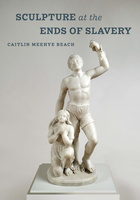
Caitlin Meehye Beach,
Sculpture at the Ends of Slavery.
Oakland, CA: University of California Press, 2022.
240 pp.; 74 color and 14 b&w illus.; index.
$60.00 (hardcover)
ISBN: 9780520343269
Beginning with the question “can an image incite change?” (1), Beach states her aim for Sculpture at the Ends of Slavery to “interrogate the place of sculpture in the transatlantic fight to abolish slavery in the United States” (3). She explains in her introduction, “‘Within a Few Steps of the Spot’: Art in an Age of Racial Capitalism,” that sculpture stood at slavery’s chronological beginning and end, functioning in conflicting, contradictory, and deeply unstable ways. The author briefly cites numerous scholars of critical race theory in order to lay the conceptual groundwork for her study. Important examples include Cedric J. Robinson on the theory of racial capitalism and Sianne Ngai and Mel Y. Chen on concepts of animatedness and animacy respectively. From the work of these scholars, she forms basic assumptions that will be applied throughout the book: that art in general and sculpture in particular were complicit with and enabled by a global capitalist economy forged by stolen labor, and that sculpture was historically considered as “life like,” and was thereby “perpetually yoked to a crisis of racialized subjectivity” (7). Beach asserts throughout the book that the portrayal, ownership, or viewing of a depiction of a Black person was most often a form of violence, and that a work’s viability can be judged by its associations, however distant, with racial capitalism. The mass of scholarship cited firmly establishes the author’s project of evaluating historical sculpture according to the criteria of present-day critical theory and is used to demonstrate its failure to meet those standards as “sculpture gave way to the complexities and fictions of the idea of abolition in an age of industrial and imperial accretion” (12).
Beach employs a case study approach, focusing on works that addressed slavery and emancipation by US and European artists, including Hiram Powers (1805–73), John Bell (1812–95), Edmonia Lewis (1844–1907), and Francesco Pezzicar (1831–90), to address how their work fit into “a larger ecosystem of labor, production, consumption, and reception” (14). Following a summary of the book’s five chapters, the author answers her initial query, asserting that the sculptures examined in this volume “were never agents in the fight for the abolition of slavery. . . . Rather, they were inert things . . . often rendered visible and spectacular through the very regimes of wealth and bodily value that enslavement afforded” (20). Beach concludes her introduction by calling for the “refusal and dismantling of structures and systems that constitute our present world” (20), providing insight into the lens through which the author will view the topic.
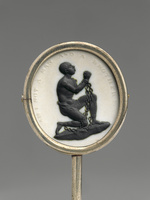
In chapter 1, “Grasping Images: Antislavery and the Sculptural,” Beach seeks to establish why sculpture was thought to be uniquely compelling and persuasive for the purposes of abolition by studying non-sculptural objects that relate to theories of spectatorship predicated on properties of touch. One foundational premise is framing perception as “a form of surveillance and possession” (24), meaning that to look at an image related to slavery was to contribute to the project of slavery itself. Beach focuses first on the well-known Wedgwood antislavery medallion inscribed “Am I Not a Man and a Brother?” (fig. 1), which was widely circulated in an attempt to build support for abolition. The author posits the racism inherent in rendering a classicized kneeling figure of an enslaved person in black, and the “white saviorism” (32) behind the making of the medallion. It is compared unfavorably to cameos that Wedgwood produced for sale of famous individuals such as Benjamin Franklin in white on blue or green jasperware, rather than the lighter-weight material that would have made the antislavery medallion affordable for wide distribution.
Beach then turns to period theories about the uniquely haptic properties of sculpture in contrast to vision and discusses objects issued by the London-based Society for Effecting the Abolition of the Slave Trade that demonstrate those properties: a diagram and a model of a slave ship that attempted to evoke the indescribable horrors of the Middle Passage. As the author points out, it is impossible to fully convey those horrors, and she posits that viewing the diagram and imagining the ship as a three-dimensional object, or holding the miniaturized model, was correlated to the bodily surveillance and control that characterized slavery. In this way, and in light of the theories invoked by Beach, the two objects “reified rather than challenged the broader hierarchies of race and power” through “the violence of the possessive and the proprietary” (38).
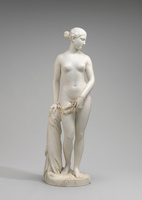
Chapter 2, “‘The Mute Language of Marble’: Slavery and Hiram Powers’s The Greek Slave,” addresses the relationship of the sculpture named in its title (fig. 2) to the economics of slavery. Beach notes the strongly resonant connection between the location of one of its many exhibition venues in New Orleans, across the street from a slave market. She points out Powers’s early-career connections with slavery advocate US Senator John Calhoun and plantation owner and state Senator John Preston, who funded the artist’s 1837 trip to Italy. Beach acknowledges that Powers’s views evolved toward abolition over time, but nonetheless concludes that the sculptor geared his work toward an art market that included patrons “connected to racist ideologies and slave economies” (51).
Beach notes the sculpture’s precedents in antiquity and faults Powers for rendering a classicized white woman in marble, in keeping with his characteristic practice and the prevailing artistic norms of his time and place. This departs from previous scholarship (acknowledged by the author), which suggested that the choice of a white woman forced white viewers to consider the issue of slavery in more immediate and universal terms. Beach examines the tension between objects as works of art and as commodities that can be owned, a topic of longstanding discussion. She notes multiple versions of the sculpture with multiple owners and exhibitions, and asserts that, in the case of collector James Robb, his ownership of a version of The Greek Slave was informed by his outlook as a businessman. The author describes its exhibition as a fundraiser to establish a home for destitute women as a chance, for some men, to see a nude female body while contributing to charity.
Beach meditates on the conceptual movement of the sculpture between the art market and the slave market, suggesting that mounting The Greek Slave on a revolving pedestal for display resulted in the “animation” of the sculpture, an act that implies that the sculptor considered it a surrogate for having power over an actual woman, rather than as a common exhibiting strategy. She asserts that the lifelikeness of The Greek Slave is not the result of Powers’s artistry, but rather of the histories of commodification that inhere in sculpted renderings of bodies. She concludes that by current scholarly standards, it “revealed very little on the subject of American slavery as a sculpture” (76).
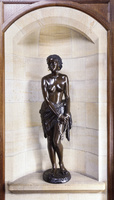
The next chapter, “Sentiment, Manufactured: John Bell and the Abolitionist Image under Empire,” addresses the English sculptor’s bronze A Daughter of Eve (fig. 3). A portrayal of an enslaved woman of African descent, it depicts the pain of captivity and represents a more direct indictment of slavery than did The Greek Slave, with its stoic serenity. However, Beach asserts that as a work of “manufactured sentiment,” the sculpture is “inextricably yoked to a long history of racial capitalism and its consequences” (79). The author discusses the state of sculpture in Britain and Bell’s bust of the abolitionist Sir Thomas Folwell Buxton for Sierra Leone. It is criticized for joining the rhetoric of ending slavery to new forms of colonialism in that country after emancipation, since true liberty was a tragically and disappointingly gradual process, as well as for elevating efforts toward passing emancipation laws over enslaved peoples’ own efforts at self-emancipation.
Returning to A Daughter of Eve, Beach examines the new electrotype process by which it was created, linking it to industrial capitalism. In spite of taking as its subject a realistic Black woman, rather than a classicized white female, the material complicated the sculptor’s attempts to promote abolitionism and “threatened to reiterate the proprietary violence of enslavement” (90). Other associations include its origins at Elkington & Co. in Birmingham, England, which was a center for metal wares, including those used in the slave trade. Though that company did not equip the slave trade, its output was nonetheless tied to exploitative economies, and the act of displaying the sculpture reified proprietary forms of surveillance. Further, it manifested the paternalist and racist attitudes incumbent in a white artist making an image of a Black person, alongside the violence inherent in the act of representation.
Examining the sculpture’s history of ownership, Beach suggests that collector and industrialist William Armstrong purchased A Daughter of Eve in order to enhance his public image, noting that he placed the sculpture in a central location in his home, but the niche was too large, emphasizing the figure’s captivity (see fig. 3). Beach also discusses Bell’s marble The Octoroon (1868; Blackburn Museum and Art Gallery, Blackburn), which was purchased by the town, presumably in a retroactive attempt to show anti-slavery sentiments in light of its textile mills’ past connections to slavery. According to the author’s web of associations, even if the sculpture brought attention to the problem of slavery, it was tainted by empire, enclosure, and enslavement.
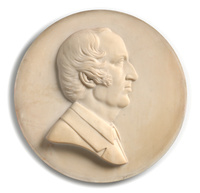
Beach notes that while the previous chapter discussed the inadequacy of sculpture as a tool for advancing abolition, the next, “Relief Work: Edmonia Lewis and the Poetics of Plaster,” explores the medium’s positive capacities. The author posits that, in the hands of a Black artist, sculptural practice can become effective political action, rather than silently imposing scopic regimes. Chapter 4 studies works by Black and Anishinaabe sculptor Edmonia Lewis and her engagement with abolitionism and abolitionists. Between 1863 and 1865, Lewis created a medallion of abolitionist John Brown (no longer extant), analogous to the Wedgwood medallion in the introduction, as well as busts and medallions of others such as Abraham Lincoln (no longer extant), Robert Gould Shaw (no longer extant), and Wendell Phillips (see fig. 4 for a later marble version).
The author traces Lewis’s early life and career, the prejudices she faced, and the obstacles that she surmounted, aided by the support of Boston abolitionists and publications who promoted and purchased her work. Beach focuses on Lewis’s work in Boston, in particular her plaster medallion of Brown, her statuette of Sergeant William H. Carney of the 54th Massachusetts Infantry (no longer extant), one of the Civil War’s first Black regiments, and her early plaster busts of Colonel Robert Gould Shaw, its white commander. In the absence of extant versions of the sculpture devoted to Carney, she evokes a sense of what it might have looked like and analyzes the early plaster and later marble versions of the Shaw bust (1867; Museum of African American History, Boston and Nantucket) through period photographs. The author discusses the fairs to aid Civil War soldiers where the works were exhibited for sale and offers an account of the Colored Ladies’ Sanitary Fair of October 1864, where the sculpture of Carney would have represented a powerful example of Black women’s activism. In describing the display of these works at the Colored Ladies’ Sanitary Fair, the author speculates that the plaster busts may have been associated with handicraft, the immediacy of the artist’s touch, and the uses of the material in healing. However, plasters and other small sculptures such as these were usually mass produced from molds and widely distributed, and given their ubiquity, it is debatable whether they were understood as such.
The chapter concludes with the Boston debut of Lewis’s Forever Free (1867; Howard University Gallery of Art, Washington, DC), a rendering in marble of an emancipated man and woman. In this chapter, white abolitionists are not characterized as paternalistic or racist, perhaps because they can be directly linked with helping Lewis achieve self-determination and success in her work. Similarly, her promotional and entrepreneurial efforts and the purchases of her work are not burdened with the commodifying tensions of ownership.
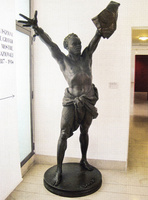
The final chapter, “Between Liberty and Emancipation: Francesco Pezzicar’s The Abolition of Slavery,” discusses the artist’s monumental sculpture The Abolition of Slavery in the United States, 1863 (fig. 5), which was displayed at the 1876 Centennial Exhibition in Philadelphia. Beach aims to look at the challenges of depicting emancipation in visual and material terms. She studies the artist’s background, the creation of the sculpture, and points to similar works by US artists. Pezzicar’s work is praised for the figure’s dynamic stance, standing with arms outstretched holding the Emancipation Proclamation in his hand, rather than kneeling before President Lincoln as in Thomas Ball’s Freedman’s Memorial (1876; Washington, DC), unveiled the same year.
Beach discusses its reception at the Centennial Exhibition, asserting that many period commentaries show that Pezzicar’s sculpture did not meet viewers’ expectations, rendering it a site of criticism. She then cites praise from two Centennial publications, and also notes one article from the Philadelphia African Methodist Church’s Christian Recorder that wished for the kind of grand, idealized figure that was often called for throughout the nineteenth century. The author asserts that much of the response was “unbridled racism masquerading as art criticism” (156), offering one example from William Dean Howells, which is indeed offensive and does not contribute to the critical discussion.
Another article of the period documented the making of the sculpture, noting that Pezzicar was said to have sought out a former US slave as a model rather than creating an idealized figure. Though the towering figure conveys agency, Beach denigrates the practice of using models of color, which “haunted the making” of the sculpture (158). In addition, the author describes the intricate technical process of lost-wax casting, with its positive and negative molds, attributing ideological significance to the process, which involves “the speculative deferral and reversal of multiple bodies” (160). In the end, Pezzicar’s sculpture also fails to be truly emancipatory by the standards of current critical race theory. Though it portrays an individualized Black man in a posture of action and power, its making was “deeply entangled in the slave past and its economy of fungibility” (159). A brief coda connects The Abolition of Slavery in the United States to the late arrival at the Centennial Exhibition of the torch-bearing arm of Frédéric-Auguste Bartholdi’s Liberty Enlightening the World, originally conceived as a response to the passage of the Thirteenth Amendment in the United States. Beach identifies it as another example of the partial and incomplete nature of representations of liberty.
Beach demonstrates her thesis that, based on her chosen methodology, the ostensibly abolitionist sculptures under discussion failed to expose sufficiently the evils of slavery and may have even promoted racism. However, the book might have benefited from a more balanced approach. In general, Beach’s evaluations are based on premises that assume the lowest intentions and require moral perfection within unassailable systems populated by people behaving flawlessly. Along the same line, materials and processes are subject to moral judgment based on associations and adjacencies, however distant. Readers may well wonder whether, according to this approach, most of these works should not have been made at all, and whether abolitionists should not have used visual aids of any kind to expose the evils of slavery.
The author might also have considered acknowledging possible ways in which these works might have promoted the cause of abolition in their time; instead, artists are faulted for using the media and forms of the period, including marble and bronze to depict bodies white and Black, and idealized and realistic. Nor are abolitionists credited for their efforts toward emancipation. Beach rightly points out the lack of attention paid to enslaved peoples’ efforts at self-emancipation. However, it is possible to highlight these neglected accounts without dismissing the work of abolitionists, who are variously characterized as paternalistic, self-interested, and complicit in furthering racism and slavery. One exception is chapter 4, in which Beach, perhaps unconsciously, softens her approach as she describes the specific actions that individual Boston abolitionists took in support of Edmonia Lewis.
An author’s point of view is always shaped to some extent by their present-day experience and interests, but this can exist in healthy dialogue with an attempt to understand the period being studied on its own terms. While our present perspective on a historical event may reveal an aspect of its nature that was not possible to articulate at the time, it is nonetheless worthwhile to understand the possibilities and limits of the era. Sculpture at the Ends of Slavery includes admirable scholarly research, but it embraces an increasingly common approach of foregrounding contemporary judgments rather than historical evidence to support its conclusions. By its nature, this approach reveals more about the author’s time than it does about the period or the objects under discussion. The volume does not contribute greatly to an understanding of how the works under discussion functioned in their own time, but it offers new ways of thinking about and understanding these works in light of the present moment.